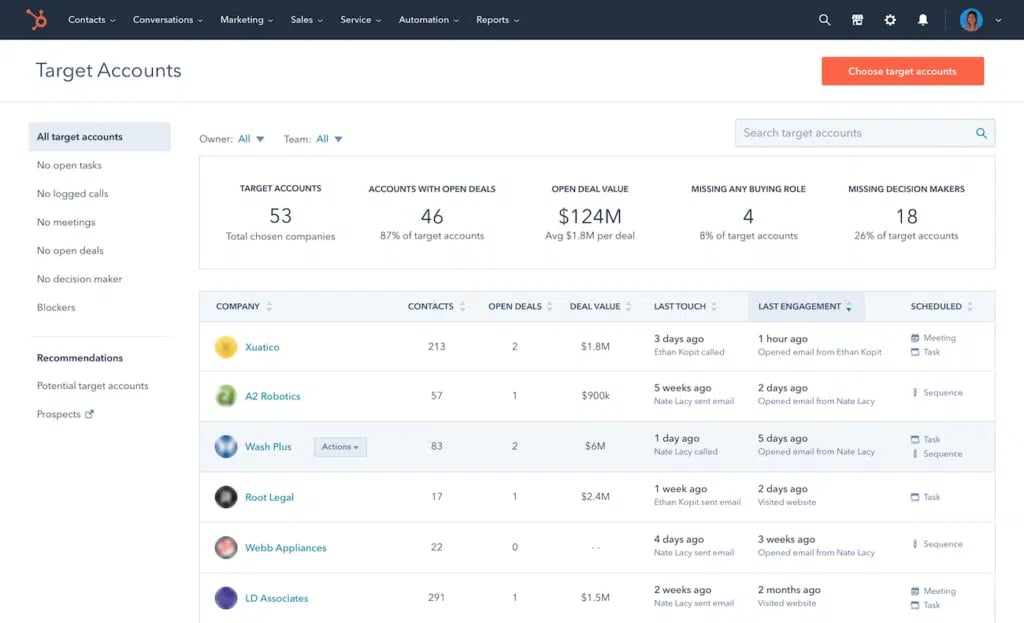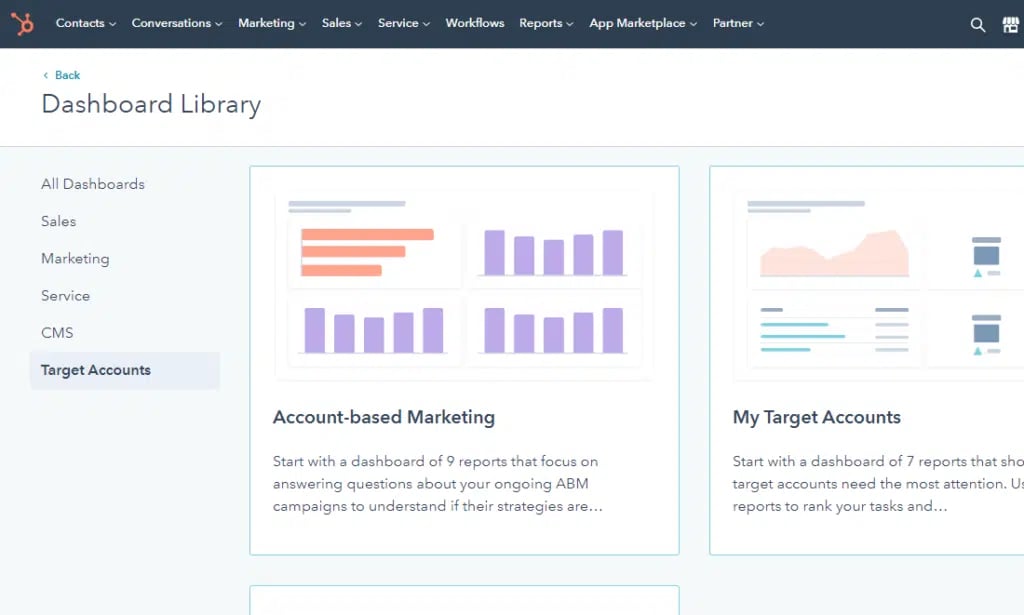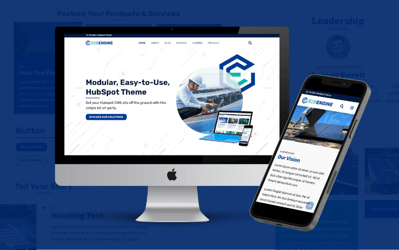HubSpot ABM Tools: 8 Essential Tips and Guide

Congratulations! You’re preparing your organization for next-level growth. But do you have a nagging sense that expanding the business could actually grind things to a halt due to the stress it will put on the company? Achieving business growth is hard. But there are a few aspects that, if attended to, will make it a whole lot easier.
The need to go to market with a coherent marketing message that is relevant to both new prospects and existing customers is mission-critical, as is making sure that your entire team is on the same page. More and more, you will also find that the larger prospects that you are looking to win over demand an approach and a solution that are specific to their needs.
Simply assuming that same direct mail piece is going to resonate with all of your target prospects, especially the big ones, is just bad business. And direct mail!? Please feel free to wake up and embrace a modern approach to marketing your product or service.
Increasingly, successful business relationships are built on a one-to-one approach that takes into consideration how your company can address a prospect’s specific needs.
All of which is why many of your competitors are embracing Account Based Marketing (ABM), and why companies like HubSpot have developed strategies and tools to help fully capitalize on its promise.
How Growth Can Magnify Dysfunction
In business, a lack of communication, poor organization, and no shared purpose add up to one proverbial kiss of death. Orders go missing; specifications are overlooked, sales and marketing goals are at odds and, most critically, customers and clients go elsewhere because they either can’t wait for your team to get its act together.
Or they are frustrated that their specific needs are not being addressed on a consistent basis. And that kind of dysfunction in business is magnified when a company is undergoing a period of growth.
A small group of focused, energized employees that once worked out of a small office space morphs, in short order, into a complex organization managed and staffed by a widely dispersed workforce doing business in multiple states.
The day-to-day challenge of staying on top of incumbent accounts is complicated by the need to meet the C-Suite’s desire to feed the beast — keep more qualified leads coming in, attract larger prospects, and drive bottom-line growth.
Let’s not forget who got your company to where it is today. Organic growth is easier and less costly to achieve than chasing down brand new accounts. How much revenue potential is being overlooked with existing accounts simply because your team is on autopilot, doing the same old same old for clients quarter after quarter?
Kudos to you if you are trying to keep on top of all of this exciting, challenging growth with cobbled-together legacy systems that don’t appear to work effectively for anyone on your team, and are so old that no one recalls who approved their use in the first place.
You may have an IT team that spends all of their time debugging, fixing, and trying to integrate newer systems that need to be bolted on to the old. This is not a recipe for success.
HubSpot ABM Tools: Account Based Marketing (ABM) Offers a Real Solution and HubSpot Makes it Work
What modern business needs is a structure and organizational support aligned to the principles of Account Based Marketing.
In an ABM-based approach, specific high-value accounts are identified and sales and marketing teams agree to follow an engagement strategy. Outreach and nurturing are designed with the specific needs of the target account in mind. The target account feels that its needs and challenges are being addressed at each point of their journey.
And transparency and professional respect help forge the creation of a mutually beneficial working relationship. Ideally, much of this work is either automated or at least prompts users to take actions that align with the company’s goal of engagement with a specific target customer.
What does ABM deliver?
- Increased focus on more relevant accounts.
- More effective initial engagement on deals.
- Alignment of account strategies, marketing initiatives, and sales engagement.
- Maximized value and impact of marketing spend.
- Engagement with customers with content that matters to them.
While this sounds great in principle, how does a company manage hundreds of these kinds of relationships simultaneously — each at a different stage of development, with a variety of target personas, business requirements, and key timelines and milestones — in order for the optimal amount of new business to be won and existing business to be retained?
The successful acquisition of new business is about effective, clear communication — nothing ambiguous, nothing off-script — built on a shared understanding of what your prospect needs. The same holds true for the retention of high value existing accounts.
The fact of business in today’s post-COVID world is that many of us are still working from home and workforces are broadly dispersed. Your ‘closest’ most mission-critical team members could be located in Denver or Denmark.
Achieving consensus in both business development and current account management was challenging to achieve when we were all in the same office building. How do we do it now, and keep it all together?
Is there a tool, system, or platform that can do all that? Short answer: Yes, there is.
An embrace of digital makes ABM a reality. But HubSpot makes that reality much easier to achieve. It refers to its solution as ABM marketing software that makes selling to high-value accounts easier than ever.
It’s a toolset that capably covers platforming, standardizing, automating, and individualizing — all important facets, and necessary tasks. And we believe it is indeed an effective way to manage an ABM-based business development and retention game plan for your business.
How and Why Do HubSpot’s ABM Tools Work So Well?
1. Keeps the focus on best-fit targets
Hubspot keeps sales and marketing aligned by creating multiple levels of account detail and information about your high-level targets. If you already know the industries you work best with and where you have the greatest success with clients, it will help you find more of the target prospects that match those criteria — in terms of size, focus area, location, and industry.
You’re prevented from wasting time on the companies that don’t match, either because they’re too small or too large, not in your wheelhouse, or will otherwise stress your organization.
2. Creates agreement around how to approach individual high-value prospects
HubSpot’s sequences system leaves no doubt about how to time communication and what will be conveyed to target prospects and key accounts — addressing the always-critical issue of alignment. Particularly within larger, sprawling organizations, this can be a game-changer.
If a prospect is having one conversation with sales and another with marketing (or any other department within your company), the overall message to the prospect is that you’re disjointed and unfocused. That may lead to the client wondering if your company is actually the kind of partner that they can effectively and efficiently work with.

3. Provides a vital early warning system
ABM with Hubspot resource support can identify problem areas and potential sources of tension in a working relationship before they become fatal. The system demands that you be closer to and more invested in a customer’s business — so there are fewer unpleasant and fiscally detrimental surprises.
It can prevent that dreaded customer lament, “Your team didn’t listen” — usually delivered as they take their business elsewhere. And it will keep the focus sharp after the initial burst of passion to land the account.
4. Guides communication
HubSpot’s system has been designed specifically to address not just when to communicate, but how — in terms of language, tone, and giving the target audience what they need. It helps ensure that what we are saying is specific to the needs of the target audience — and both motivational and engaging.
But back to timing: the system also helps get a solid nurture sequence in place that balances our need to connect with meaningful content and a prospect’s desire to not be overwhelmed by empty salesmanship.
5. Integrates with other software
HubSpot is a software stack-friendly integration to many leading business software systems, including Slack, LinkedIn, Sigstr, Madison Logic, RollWorks, and Triblio. That makes it far easier to customize your approach and stay connected and efficient as an organization.
6. Has powerful but simple tracking and reporting tools
HubSpot is designed to simultaneously track hundreds of accounts with a range of sales cycle timelines. Its reporting tools makes account analysis easy, enabling you to do more of what works and less of what doesn’t.
Its dashboards and performance metrics can be transparently shared with your team, so everyone can track performance against objectives. (And if things are not tracking as expected, it’s easy to stop, recalibrate and pivot to an approach that starts moving the needle.)

7. It works right out of the box
HubSpot is a fast ramp-up, focused on ease of use in tracking, reporting, and executing marketing activities, requiring just minimal IT staff or third-party vendor intervention.
8. It will help you do what you need to do
Each customer wants to feel special. They want to feel that their specific wants and concerns are being addressed. HubSpot allows your team the ability to achieve this at scale — and deliver motivating messaging to different client-side target audiences based on what they need to hear to sign on with you.
High-value accounts, more personalized engagement, and the ability to forge deeper relationships: that’s the key.

Not All Pivots Are Good Pivots
Done right, with proper dashboards and communications channels established, Hubspot alerts you on when you need to modify your approach with a particular account, regardless of how many pieces of high-value business you are managing.
This allows you to avoid pitfalls, such as having new projects or business that would have normally come to your company go elsewhere; going through a reorganization within your or the client’s company which changes your relationship; or not having clear ROI.
But it also reminds you that the prospect is tantamount: that business you are chasing, especially high-value business, expects to be treated with care and specific attention paid to their pressing needs. You know they’ve shopped around and done their research, and yes, you’re on a shortlist. But remember, it’s still a list, along with competitors just as hungry for their business.
Hubspot gives you the edge you need — helping you make sure that your sales and marketing teams are on the same page and speaking with a common voice. It helps you effectively and efficiently manage the pursuit of multiple high-value opportunities — so you can also pursue your goal of growth.
If Growth is Your Goal, ABM Could Be Your Blueprint
Let’s focus on growth for a moment: that business growth is highly desirable is a statement worthy of Captain Obvious. Yet growth without a foundational management system in place is doomed to fail.
That system needs to be there to identify best fit leads; determine an optimal communications strategy with supporting tactics; facilitate collaboration and coordination within your team; and put dashboards in place to measure and manage KPI performance at scale. ABM allows that level of focus and personalization.
Similarly, an ABM program helps you better execute the management and retention of existing high-value accounts, so attention is paid when and where needed in order to protect and organically grow those existing pieces of business on which your company has been built.
Finally, it’s all about win rate. A software solution like HubSpot that is designed to facilitate the implementation of ABM leaves less to chance and therefore increases your prospective win rate as you go in search of the accounts necessary to meet your growth goals.
And while this approach may seem overwhelming, it could lead to a complete shift in how you manage current accounts and go to market for new ones.
We are a HubSpot Platinum Certified Partner with over six years of experience with the platform and over 15 years of experience in digital business transformation and growth. That makes us uniquely positioned to be your partner in this important process and help bring about the seismic shift your business is looking for.
Are you ready to kick off your ABM strategy? Reach out to New Perspective. Our dedicated, experienced team can help you identify whether ABM is a good fit for your business — and we can help you start strategizing right away. Let’s talk.




